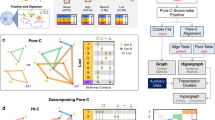Abstract
Chromatin conformation capture technologies are a vital source of information about the spatial organization of chromatin in eukaryotic cells. Of these technologies, Hi-C and related methods have been widely used to obtain reasonably complete contact maps in many cell lines and tissues under a wide variety of conditions. This data allows for the creation of chromatin interaction graphs from which topological generalizations about the structure of chromatin may be drawn. Here we outline and utilize a clique-based approach to analyzing chromatin interaction graphs which allows for both detailed analysis of strongly interconnected regions of chromatin and the unraveling of complex relationships between genomic loci in these regions. We find that clique-rich regions are significantly enriched in distinct gene ontologies as well as regions of transcriptional activity compared to the entire set of links in the respective datasets, and that these cliques are also not entirely preserved in randomized Hi-C data. We conclude that cliques and the denser regions of connectivity in which they are common appear to indicate a consistent pattern of chromatin spatial organization that resembles transcription factories, and that cliques can be used to identify functional modules in Hi-C data.
Supported by the Latvian Council of Science project lzp-2021/1-0236.
Access this chapter
Tax calculation will be finalised at checkout
Purchases are for personal use only
Similar content being viewed by others
References
Adams, D., Altucci, L., et al.: BLUEPRINT to decode the epigenetic signature written in blood. Nat. Biotechnol. 30(3), 224–226 (2012). https://doi.org/10.1038/nbt.2153
Ashburner, M., Ball, C.A., et al.: Gene Ontology: tool for the unification of biology. Nat. Genet. 25(1), 25–29 (2000). https://doi.org/10.1038/75556
Cairns, J., Freire-Pritchett, P., et al.: CHiCAGO: robust detection of DNA loo** interactions in Capture Hi-C data. Genome Biol. 17(1), 127 (2016). https://doi.org/10.1186/s13059-016-0992-2
Collas, P., Liyakat Ali, T.M., et al.: Finding friends in the crowd: three-dimensional cliques of topological genomic domains. Front. Genet. 10, 602 (2019). https://doi.org/10.3389/fgene.2019.00602
Cunningham, F., Allen, J.E., et al.: Ensembl 2022. Nucleic Acids Res. 50(D1), D988–D995 (2022). https://doi.org/10.1093/nar/gkab1049
Grubert, F., Srivas, R., et al.: Landscape of cohesin-mediated chromatin loops in the human genome. Nature 583(7818), 737–743 (2020). https://doi.org/10.1038/s41586-020-2151-x
Javierre, B.M., Sewitz, S., et al.: Lineage-specific genome architecture links enhancers and non-coding disease variants to target gene promoters. Cell 167(5), 1369–1384.e19 (2016). https://doi.org/10.1016/j.cell.2016.09.037
Jha, R.K., Levens, D., Kouzine, F.: Mechanical determinants of chromatin topology and gene expression. Nucleus 13(1), 95–116 (2022). https://doi.org/10.1080/19491034.2022.2038868
Jung, I., Schmitt, A., et al.: A compendium of promoter-centered long-range chromatin interactions in the human genome. Nat. Genet. 51(10), 1442–1449 (2019). https://doi.org/10.1038/s41588-019-0494-8
Kim, K., Jang, I., et al.: 3DIV update for 2021: a comprehensive resource of 3D genome and 3D cancer genome. Nucleic Acids Res. 49(D1), D38–D46 (2021). https://doi.org/10.1093/nar/gkaa1078
Klopfenstein, D.V., Zhang, L., et al.: GOATOOLS: a python library for gene ontology analyses. Sci. Rep. 8(1), 10872 (2018). https://doi.org/10.1038/s41598-018-28948-z
Kundaje, A., Meuleman, W., et al.: Integrative analysis of 111 reference human epigenomes. Nature 518(7539), 317–330 (2015). https://doi.org/10.1038/nature14248
Lieberman-Aiden, E., Van Berkum, N.L., et al.: Comprehensive map** of long-range interactions reveals folding principles of the human genome. Science 326(5950), 289–293 (2009). https://doi.org/10.1126/science.1181369
Liu, L., Li, Q.Z., et al.: Revealing gene function and transcription relationship by reconstructing gene-level chromatin interaction. Comput. Struct. Biotechnol. J. 17, 195–205 (2019). https://doi.org/10.1016/j.csbj.2019.01.011
Liyakat Ali, T.M., Brunet, A., et al.: TAD cliques predict key features of chromatin organization. BMC Genom. 22(1), 499 (2021). https://doi.org/10.1186/s12864-021-07815-8
Lohia, R., Fox, N., Gillis, J.: A global high-density chromatin interaction network reveals functional long-range and trans-chromosomal relationships. Genome Biol. 23(1), 238 (2022). https://doi.org/10.1186/s13059-022-02790-z
Maeshima, K., Tamura, S., et al.: Fluid-like chromatin: toward understanding the real chromatin organization present in the cell. Curr. Opin. Cell Biol. 64, 77–89 (2020). https://doi.org/10.1016/j.ceb.2020.02.016
Mora, A., Huang, X., et al.: Chromatin hubs: a biological and computational outlook. Comput. Struct. Biotechnol. J. 20, 3796–3813 (2022). https://doi.org/10.1016/j.csbj.2022.07.002
Pancaldi, V.: Network models of chromatin structure. Curr. Opin. Genet. Dev. 80, 102051 (2023). https://doi.org/10.1016/j.gde.2023.102051
Sanalkumar, R., Dong, R., et al.: Highly connected 3D chromatin networks established by an oncogenic fusion protein shape tumor cell identity. Sci. Adv. 9(13) (2023). https://doi.org/10.1126/sciadv.abo3789
Sandhu, K.S., Li, G., et al.: Large-scale functional organization of long-range chromatin interaction networks. Cell Rep. 2(5), 1207–1219 (2012). https://doi.org/10.1016/j.celrep.2012.09.022
Sutherland, H., Bickmore, W.A.: Transcription factories: gene expression in unions? Nat. Rev. Genet. 10(7), 457–466 (2009). https://doi.org/10.1038/nrg2592
Szabo, Q., Bantignies, F., Cavalli, G.: Principles of genome folding into topologically associating domains. Sci. Adv. 5(4) (2019). https://doi.org/10.1126/sciadv.aaw1668
Tao, H., Li, H., et al.: Computational methods for the prediction of chromatin interaction and organization using sequence and epigenomic profiles. Brief. Bioinf. (2021). https://doi.org/10.1093/bib/bbaa405
Volpi, E., Chevret, E., et al.: Large-scale chromatin organization of the major histocompatibility complex and other regions of human chromosome 6 and its response to interferon in interphase nuclei. J. Cell Sci. 113(9), 1565–1576 (2000). https://doi.org/10.1242/jcs.113.9.1565
Author information
Authors and Affiliations
Corresponding author
Editor information
Editors and Affiliations
Rights and permissions
Copyright information
© 2023 The Author(s), under exclusive license to Springer Nature Singapore Pte Ltd.
About this paper
Cite this paper
Melkus, G. et al. (2023). Clique-Based Topological Characterization of Chromatin Interaction Hubs. In: Guo, X., Mangul, S., Patterson, M., Zelikovsky, A. (eds) Bioinformatics Research and Applications. ISBRA 2023. Lecture Notes in Computer Science(), vol 14248. Springer, Singapore. https://doi.org/10.1007/978-981-99-7074-2_38
Download citation
DOI: https://doi.org/10.1007/978-981-99-7074-2_38
Published:
Publisher Name: Springer, Singapore
Print ISBN: 978-981-99-7073-5
Online ISBN: 978-981-99-7074-2
eBook Packages: Computer ScienceComputer Science (R0)




